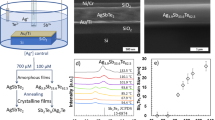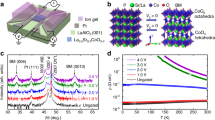Abstract
Semiconductors are key materials in modern electronics and are widely used to build, for instance, transistors in integrated circuits as well as thermoelectric materials for energy conversion, and there is a tremendous interest in the development and improvement of novel materials and technologies to increase the performance of electronic devices and thermoelectrics. Tetramorphic Ag10Te4Br3 is a semiconductor capable of switching its electrical properties by a simple change of temperature. The combination of high silver mobility, a small non-stoichiometry range and an internal redox process in the tellurium substructure causes a thermopower drop of 1,400 μV K−1, in addition to a thermal diffusivity in the range of organic polymers. The capability to reversibly switch semiconducting properties from ionic to electronic conduction in one single compound simply by virtue of temperature enables novel electronic devices such as semiconductor switches.
This is a preview of subscription content, access via your institution
Access options
Subscribe to this journal
Receive 12 print issues and online access
$259.00 per year
only $21.58 per issue
Buy this article
- Purchase on Springer Link
- Instant access to full article PDF
Prices may be subject to local taxes which are calculated during checkout







Similar content being viewed by others
References
Keen, D. A. Disordering phenomena in superionic conductors. J. Phys. Condens. Matter 14, R819–R857 (2002).
Knauth, P. & Tuller, H. L. Solid-state ionics: Roots, status, and future prospects. J. Am. Ceram. Soc. 85, 1650–1680 (2002).
Hull, S. Superionics: Crystal structures and conduction processes. Rep. Prog. Phys. 67, 1233–1314 (2004).
Wagner, C. The electromotive force of the cell: Ag|AgI|Ag2S|Pt(+S). Z. Elektrochem. Angew. Phys. Chem. 40, 364–365 (1934).
Miyatani, S. Electrical properties of the pseudo-binary systems Ag2TexSe1−x, Ag2TexS1−x, and Ag2SexS1−x . J. Phys. Soc. Jpn. 15, 1586–1595 (1960).
Yokota, I. On the theory of mixed conduction with special reference to conduction in silver sulfide group semiconductors. J. Phys. Soc. Jpn. 16, 2213–2223 (1961).
Rickert, H. & Wagner, C. Stationary conditions and stationary transport occurrences in silver sulfide in a temperature gradient. Ber. Bunsenges. Phys. Chem. 67, 621–629 (1963).
Wysk, H. & Schmalzried, H. Electrochemical investigation of the α/β-phase transition of silver sulfide. Solid State Ion. 96, 41–47 (1997).
Shukla, A. K. & Schmalzried, H. Electron transport studies of α-silver sulfide. Z. Phys. Chem. 118, 59–67 (1979).
Rickert, H. & Wiemhöfer, H.-D. Stability behavior of mixed conducting solids after applying electrical potential differences—Measurements with point electrodes on Ag2S and Cu2S. Ber. Bunsenges. Phys. Chem. 87, 236–239 (1983).
Kleinfeld, M. & Wiemhöfer, H.-D. Chemical diffusion-coefficients and stability of CuInS2 and CuInSe2 from polarization measurements with point electrodes. Solid State Ion. 28, 1111–1115 (1988).
Waser, R. & Aono, M. Nanoionics-based resistive switching memories. Nature Mater. 6, 833–840 (2007).
van Ruitenbeek, J. Silver nanoswitch. Nature 433, 21–22 (2005).
Terabe, K., Hasegawa, T., Nakayama, T. & Aono, M. Quantized conductance atomic switch. Nature 433, 47–50 (2005).
Maier, J. Nanoionics: Ion transport and electrochemical storage in confined systems. Nature Mater. 4, 805–818 (2005).
Bonnecaze, G., Lichanot, A. & Gromb, S. Electronic and electrogalvanic properties of α silver telluride. J. Phys. Chem. Solids 44, 967–974 (1983).
Preis, W. & Sitte, W. Electrochemical cell for composition dependent measurements of electronic and ionic conductivities of mixed conductors and application to silver telluride. Solid State Ion. 76, 5–14 (1995).
Riess, I. I–V relations in semiconductor with ionic motions. J. Electroceram. 17, 247–253 (2006).
Sales, B. C. Critical overview of recent approaches to improved thermoelectric materials. Int. J. Appl. Ceram. Tech. 4, 291–296 (2007).
Sales, B. C. Smaller is cooler. Science 295, 1248–1249 (2002).
Lange, S. & Nilges, T. Ag10Te4Br3: A new silver(I) (poly)chalcogenide halide solid electrolyte. Chem. Mater. 18, 2538–2544 (2006).
Lange, S. Polymorphism, structural frustration, and electrical properties of the mixed conductor Ag10Te4Br3 . Chem. Mater. 19, 1401–1410 (2007).
Nilges, T., Bawohl, M. & Lange, S. Ag10Te4Br3−xClx and Ag10Te4Br3−yIy: Structural and electrical property tuning of a mixed conductor by partial anion substitution. Z. Naturforsch. 62b, 955–964 (2007).
Nilges, T. & Bawohl, M. Structures and thermal properties of silver(I) (poly)chalcogenide halide solid solutions Ag10Te4−(q,p)Q(q,p)Br3 with Q=S, Se. Z. Naturforsch. 63b, 629–636 (2008).
Lange, S., Bawohl, M. & Nilges, T. Crystal structures, thermal and electrical properties of the new silver (poly)chalcogenide halides Ag23Te12Cl and Ag23Te12Br. Inorg. Chem. 47, 2625–2633 (2008).
Fujikane, M., Kurosaki, K., Muta, H. & Yamanaka, S. Thermoelectric properties of α- and β-Ag2Te. J. Alloys Compounds 393, 299–301 (2005).
Kurosaki, K., Kosuga, A., Muta, H., Uno, M. & Yamanaka, S. Ag9TlTe5: A high-performance thermoelectric bulk material with extremely low thermal conductivity. Appl. Phys. Lett. 87, 061919 (2005).
Papoian, G. A. & Hoffmann, R. Hypervalenzverbindungen in einer, zwei und drei Dimensionen: Erweiterung des Zintl–Klemm–Konzepts auf nichtklassische elektronenreiche Netze. Angew. Chem. 112, 2500–2544 (2000).
Wu, H.-L., Goff, W. & Phillips, P. Insulator–metal transitions in random lattices containing symmetrical defects. Phys. Rev. B 45, 1623–1628 (1992).
Korte, C. & Janek, J. Nonisothermal transport properties of α-Ag2+dS: Partial thermopowers of electrons and ions, the Soret effect and heats of transport. J. Phys. Chem. Solids 58, 623–637 (1997).
Dordor, P., Marquestaut, E. & Villeneuve, G. Dispositif de mesures du pouvoir thermoélectrique sur des échantillons très résistants entre 4 et 300 K. Rev. Phys. Appl. 15, 1607–1612 (1980).
Dovesi, R. CRYSTAL06, Torino, Italy, (2007).
Towler, M. D., Causa, M. & Zupan, A. Density functional theory in periodic systems using local Gaussian basis sets. Comput. Phys. Commun. 98, 181 (1996).
Becke, A. & Edgecombe, K. E. A simple measure of electron localization in atomic and molecular systems. J. Chem. Phys. 92, 5397–5403 (1990).
Savin, A., Nesper, R., Wengert, S. & Fässler, T. E. Die Elektronenlokalisierungsfunktion—ELF. Angew. Chem. 109 1892–1918 (1997); ELF: The electron localization function. Angew. Chem. Int. Ed. Engl. 36, 1808–1832 (1997).
Weihrich, R., Anusca, I. & Zabel, M. Halbantiperowskite: Zur Struktur der Shandite M3/2AS (M=Co, Ni; A=In, Sn) und ihren Typ-Antitypbeziehungen. Z. Anorg. Allg. Chem. 631, 1463–1470 (2005).
Penner, G. H. & Wenli, L. Silver 109 NMR spectroscopy of inorganic solids. Inorg. Chem. 43, 5588–5597 (2004).
Acknowledgements
This work was supported by the Deutsche Forschungsgemeinschaft (DFG), Sonderforschungsbereich 458. We thank W. Hermes for the Cp measurements.
Author information
Authors and Affiliations
Contributions
S.L. prepared the sample, performed the phase analyses and carried out the chemical characterizations. M.B., M.J., J.M.D. and H.D.W. conducted the electrochemical experiments and R.D. and B.C. measured the thermoelectric data. NMR spectra were recorded and interpreted by J.V. and H.E., R.W. carried out the quantum chemical calculations and T.N. devised the project and planed all project steps, interpreted all thermoelectric and structure data and wrote the manuscript.
Corresponding author
Supplementary information
Supplementary Information
Supplementary Information (PDF 1100 kb)
Rights and permissions
About this article
Cite this article
Nilges, T., Lange, S., Bawohl, M. et al. Reversible switching between p- and n-type conduction in the semiconductor Ag10Te4Br3. Nature Mater 8, 101–108 (2009). https://doi.org/10.1038/nmat2358
Received:
Accepted:
Published:
Issue Date:
DOI: https://doi.org/10.1038/nmat2358
This article is cited by
-
Discovery of colossal Seebeck effect in metallic Cu2Se
Nature Communications (2019)
-
Dramatic Changes in Thermoelectric Power of Germanium under Pressure: Printing n–p Junctions by Applied Stress
Scientific Reports (2017)
-
Synergistic, ultrafast mass storage and removal in artificial mixed conductors
Nature (2016)
-
The matryoshka effect
Nature (2012)
-
Highly Dynamic Chalcogen Chains in Silver(I) (Poly)Chalcogenide Halides: a New Concept for Thermoelectrics?
Journal of Electronic Materials (2010)



